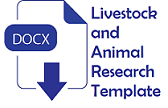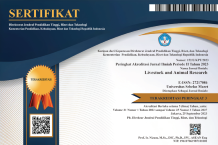Pengaruh daur ulang litter terhadap kualitas litter dan udara dalam pemeliharaan broiler
Abstract
Objective: In general, farmers use litters from rice husks. However, along with the decline in paddy fields, rice husk is difficult to obtain and the price is expensive. One effort that can be done is to reuse the litter that has been used. The purpose of this study is to analyze the effect of recycling on the quality of litter and air in raising broiler.
Methods: Two hundred day old chick (DOC) males strain Ross jumbo with an average body weight of 44.74±2.21 g were used in this research. The research treatmens were divided into 3 mini closed-house cages (LB: new litter, LFPM: litter fermented and sun-dried, LFPA: litter fermented and aerated). The data of litter quality (pore structure, total bacteria, moisture content, and adsorption percentage) and air quality (carbon dioxide, ammonia, hydrogen sulfide concentration, and dust total) were collected. The data of moisture and adsorption percentage of litter were analyzed statistically using Completely Randomized Design (SAS 9.0). Total bacteria, litter pore structure and air quality were analyzed using descriptive analysis.
Results: The results showed that reusing litter did not influence the percentage of moisture and litter adsorption. The pore surface area of litter was not affected by the different treatments. The fermented and sun-dried litter showed a larger decreasing of total bacteria (57.75%) compare to the fermented and aerated litter (41%). Carbon dioxide, ammonia, hydrogen sulfide concentration, and dust total in all treatments were within the normal standard.
Conclusions: In conclusion, litter and air quality were not affected by reusing litter.
Keywords
Full Text:
PDF (Bahasa Indonesia)References
- BPS. Badan pusat statistik tabel dinamis [internet]. Badan Pusat Statistik; 2018 [cited 2019 Feb 23] Available from. https://www.bps.go.id/linkTableDinamis/view/id/895.
- Atapattu, N. S. B. M., L. G. E. Lakmal, and P.W.A. Perera. 2017. Effects of two litter amendments on air NH3 levels in broiler closed-houses. Asian-Austral. J. Anim. Sci. 30:1500-1506. Doi:10.5713/ajas.16.0873
- Monira, K. N., M. A. Islam, M. J. Alam, and M. A. Wahid. 2003. Effect of litter materials on broiler performance and evaluation of manureal value of used litter in late autumn. Anim. Sci. 16:555-557. Doi:10.5713/ajas.2003.555
- Kelleher, B. P., J. J. Leahy, A. M. Henihan, T. F. O’dwyer, D. Sutton, and M. J. Leahy. 2002. Advances in poultry litter disposal technology–a review. Bioresour. Technol. 83:27-36. Doi:10.1016/S0960-8524(01)00133-X
- Cook, A., J. Odumeru, S. Lee, and F. Pollari. 2012. Enumeration and subtypes on retail chicken breasts with and without skin. J. Food Prot. 75:34-40. Doi:10.4315/0362-028X
- Kwak, W. S. 2005. Effect of processing time on enteric bacteria survival and on temperature and chemical composition of broiler poultry litter processed by two methods. Bioresour. Tehnol. 9:1529-1536. Doi:10.1016/j.biortech. 2004.12.018
- Muniz, E., D. Mesa, and A. M. Souza. 2013. Presence of Salmonella spp. in reused broiler litter. Rev. Colomb. Cienc. Pec. 2:12-17.
- Desiati, R. D., E. Sugiarti, and S. Ramadhany.2018. Analisa ukuran partikel serbuk komposit nicral dengan penambahan reaktif elemen untuk aplikasi lapisan tahan panas. Metalurgi. 1:27-34.Doi:10.14203/metalurgi.v33i1.358
- Standar Nasional Indonesia. 1996. Bata beton (Paving block). Badan Standardisasi Nasional, Bandung.
- Pelczar, M. J. and E. C. S. Chan. 2009. Dasar-dasar mikrobiologi. Jilid 2. Hadioetomo dkk, penerjemah. Terjemahan dari: Elements of Microbiology. UI Press, Jakarta.
- Standar Nasional Indonesia. 2005. SNI No 19-7117.7 tentang emisi gas buang. Sumber tidak bergerak. Bagian 7 cara uji Hydrogen Sulfida (H2S) dengan metode biru metilen menggunakan spektrofotometer. Badan Standardisasi Nasional, Jakarta.
- Standar Nasional Indonesia. 2004. SNI no SNI 16-7058 tentang pengukuran kadar debu total di udara tempat kerja, Badan Standardisasi Nasional, Jakarta.
- Mattjik, A. A. and Sumertajaya. 2006. Perancangan percobaan. Ed ke-2. IPB Press, Bogor.
- Miles, D. M., S. L. Branton, and B. D. Lott. 2004. Atmospheric ammonia is detrimental to the performance of modern commercial broilers. Poult. Sci. 83:650–1654. Doi:10.1093/ps/83.10.1650
- Saksrithai, K. and A. J. King. 2018. Controlling hydrogen sulfide emissions during poultry productions. J. Anim. Feed Sci. 3:1-14. Doi:10.21767/2572-5459.100040
- Martins, R. S., M. J. Hötzel, and R. Poletto. 2014. Influence of in-house composting of reused litter on litter quality, ammonia volatilisation and incidence of broiler foot pad dermatitis. Br. Poult. 54:669-676 Doi:10.1080/00071668. 2013.838747
- Ni, J. Q., A. J. Heber, S. M. Hanni, T. T. Lim, and C. A. Diehl. 2010. Characteristics of ammonia and carbon dioxide releases from layer hen manure. Br. Poult. 51:326-334. Doi:10.1080/00071668.2010
- Homidan, A. A., J. F. Robertsonz, and A. M. Petchey. 2003. Review of the effect of ammonia and dust concentrations on broiler performance. World Poultry Sci. J. 59:340-349. Doi:10.1079/WPS20030021
- Wijayanti, H. 2009. Karbon aktif dari sekam padi: pembuatan dan kapasitasnya untuk adsorpsi larutan asam asetat. Info Tehnologi. 10:61-67.
- Costa, M. S. S. M., L. A. M. Costa, A. Pela, A. C. J. Silva, L. D. Decarli, and U. F. Matter. 2006. Desempenho de quatro sistemas para compostagem de carcaça de aves. Braz. J. Poultry Sci. 10:692-698. Doi:10.1590/S1415-43662006000300023
- Macklin, K. S., J. B. Hess, S. F. Bilgili, and R. A. Norton. 2006. Effects of in-house composting of litter on bacterial levels. J. Appl. Poult. Res. 15:531-537. Doi:10.1093/japr/15.4.531
- Schneider M, Marison I, Stockar U. 1996. The importance of ammonia in mammalian cell culture. J. Biotechnol. 46:161-185.
- Saravanan, K. 2018. A Study on the concept of reutilization of litter in broiler poultry farms. Int. J. Eng. Res. Gen. Sci. 6:30-34.
- Lopes, M., V. F. B. Roll, F. L. Leite, M. A. D. Prá, E. G. Xavier, T. Heres, and B. S. Valente. 2013. Quicklime treatment and stirring of different poultry litter substrates for reducing pathogenic bacteria counts. Poult. Sci. 9:638-644. Doi:10.3382/ps.2012-02700
- Marin, I. F. F., J. A. O. Saraz, C. F. Souza, and M. F. A. Vieira. 2015. Evaluation of the fertilizer and contamination potential of different broiler litter types subjected to various use cycles. Rev. Fac. Nac. Agron. Medellin. 68:63-74 doi:10.15446/rfnam.v68n2.50967
- Sousa, F. C., M. Barbari, F. Baptista, C. F. Souza1, A. O. Saraz, D. J. R. Coelho, and A. L. Silva. 2018. Diagnosis of air quality in broilers production facilities in hot climates. Agron. Res. 16:582-592. Doi:10.15159/AR.18.070
- Guarrasi, J., C. Trask, and S. Kirychuk. 2015. A sistematic review of occupational exposure to hydrogen sulfide in livestock operational. J. Agromedicine. 20:225-236. doi:10.1080/1059924X.2015.1009667
- Skora, J., K. Matusiak, P. Wojewódzki, A. Nowak, M. Sulyok, A. Ligocka, Okrasa, M. A. Hermann, and B. Gutarowska. 2016. Evaluation of microbiological and chemical contaminants in poultry farms. Int. J. Environ. Res. Public Health. 13:192-207. Doi:10.3390/ijerph13020192
- Ulupi, N., Salundik, D. Margisuci, R. Hidayatun, and B. Sugiarto. 2015. Growth performance and production of ammonia and hydrogen sulfide in excreta of broiler chickens fed basil (Ocimum basilicum) flour in feed. Int. J. Poult. Sci. 14:112-116. Doi:10.3923/ijps.2015.112.116
Refbacks
- There are currently no refbacks.










